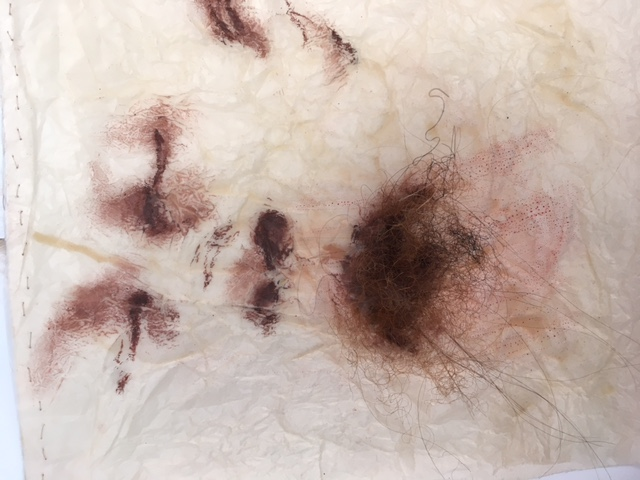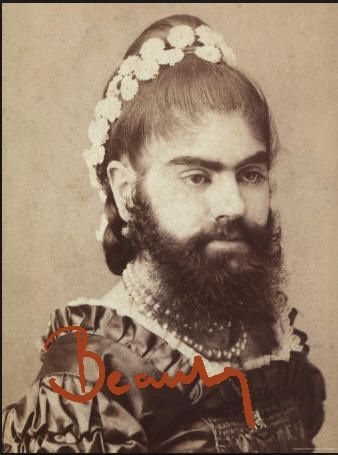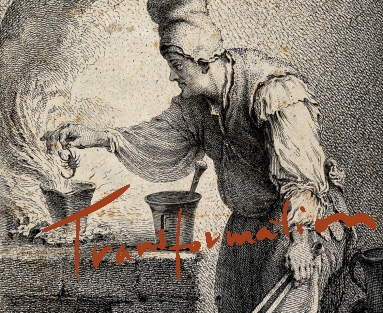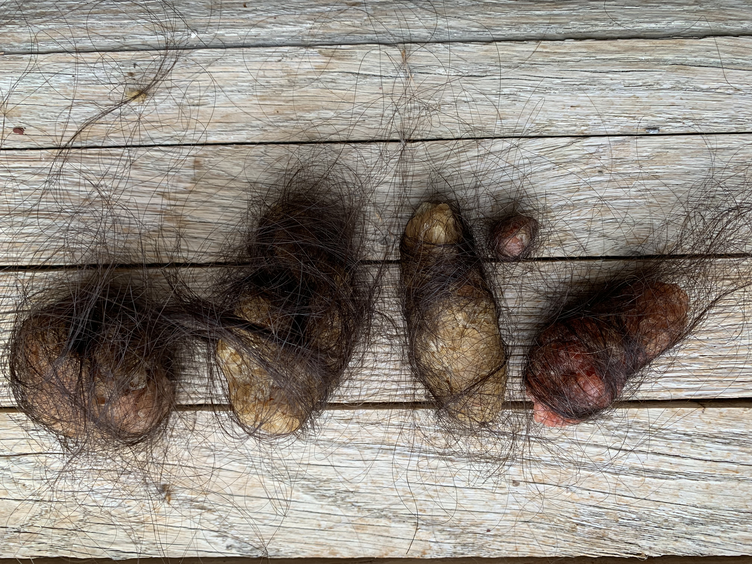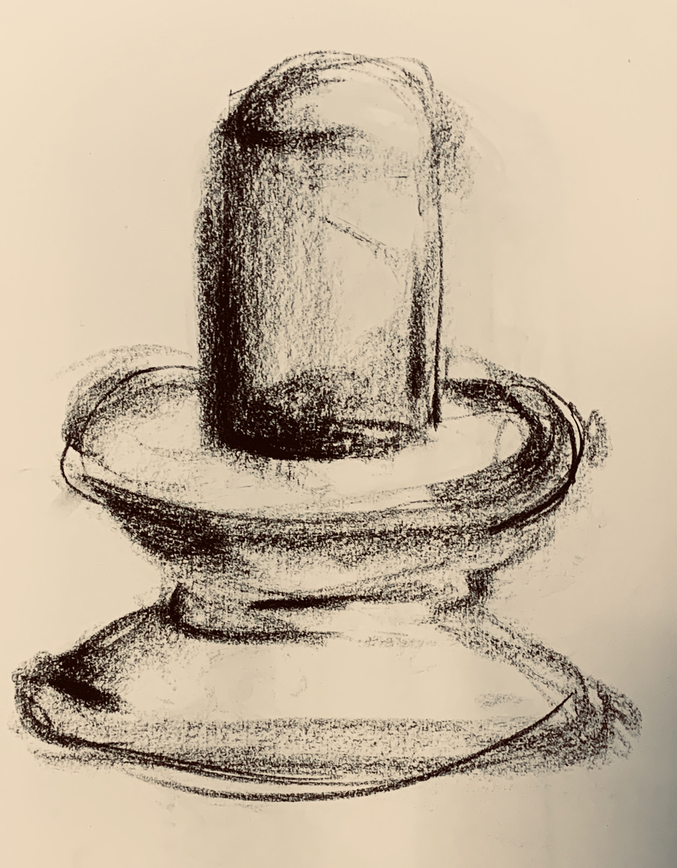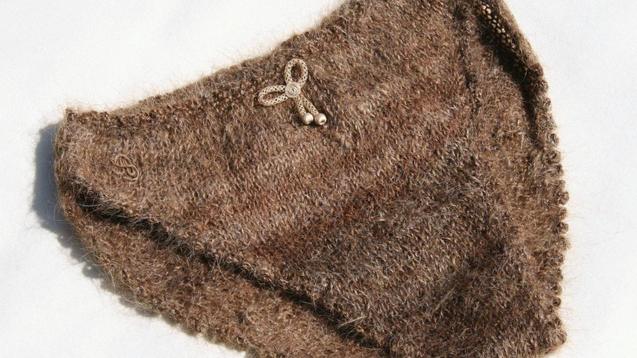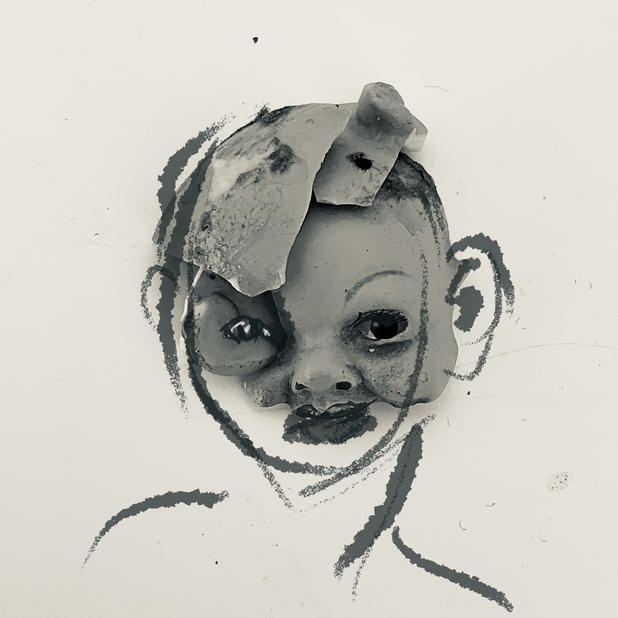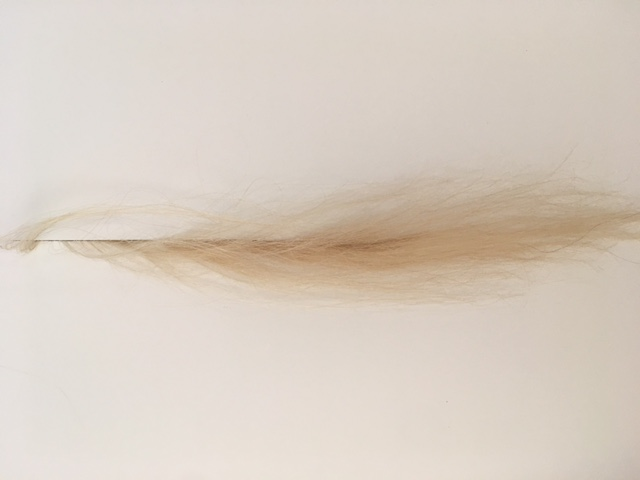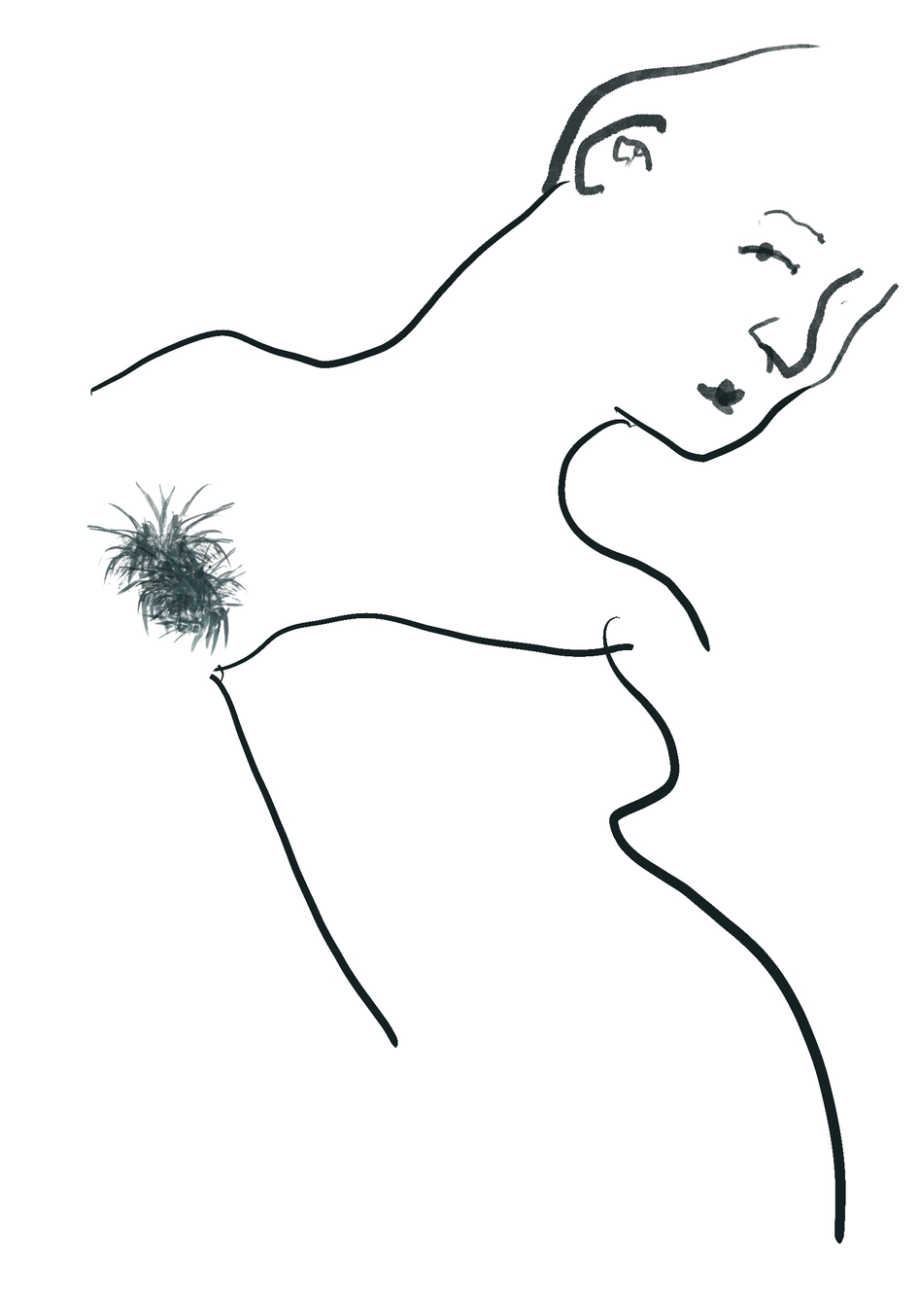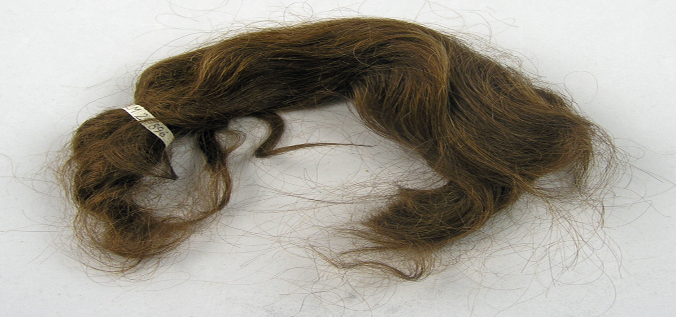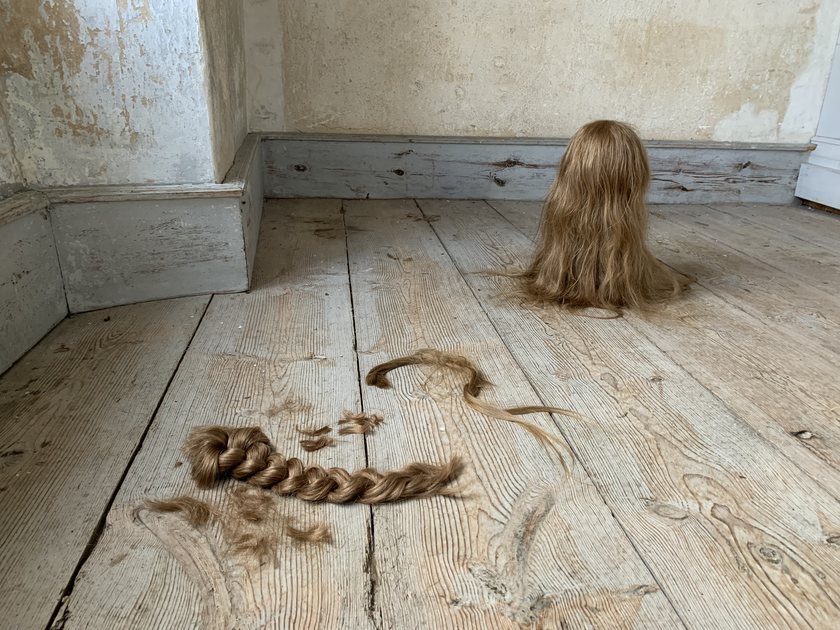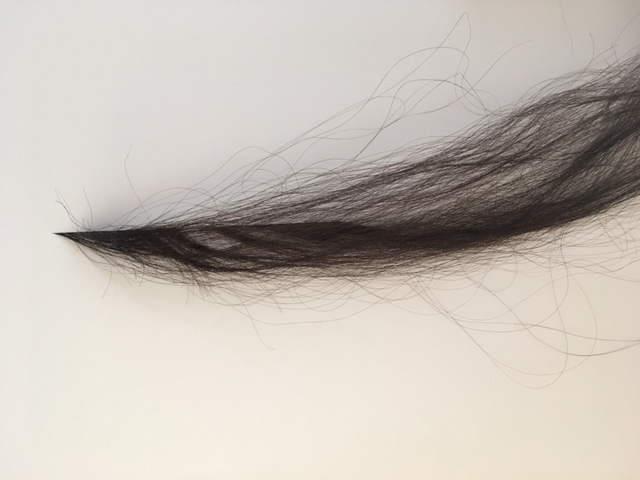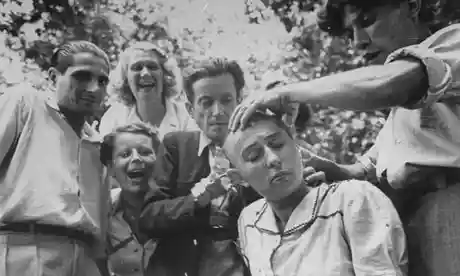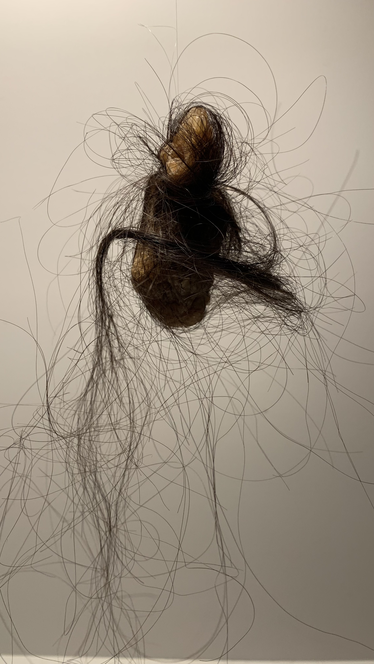Can a material create or “carry” a narrative on its own?
What dwells in a material? Something immanent i.e., a content that can emerge and create a narrative? This research project focuses on material and materiality, and the material in this case is human hair. A material that is one of the most used when it comes to the “hands on” craft of my profession as a Wig-Designer in Performing Arts. Is it possible to extract matter, the materiality, from the material? Could one evoke and define the presumed inherent qualities in a material?
To single out the essence in a material turned out to be a difficult task. I did do quite a lot of try and error initially. But there was always a context to relate to, a juxtaposition, a word, a concept etc., that added new or different ways of perceiving or interpret that which was at hand, or at sight. No surprise. After all, what was expected? A search for narratives would of course be a hopeless quest if it weren’t for just this. The juxtapositions are at the core of all creative and communicative processes, and not least in the center of the co-creative processes that constitutes Performing Arts.
Nevertheless, I still think it’s possible so see the impact a material could have when it comes to narratives, immanent stories that slumbers within a material. But what is that? Pure immanence, pure matter or encounters and relations with a subject and this subjects preconceptions and experiences?
The human hair, not just any material.
Human hair is a material that I would argue is far from neutral and quite complex. It is a corporeal and organic material and as such also linked to a multitude of notions, preconceptions and codes. An examination of this material therefore indirectly touches on an equally important part of my profession. The one that deals with visual design and what one might call a semiotics of the stage, and maybe foremost the body and its codes.
In Simon O’Sullivans book on Art Enconters he quotes Gilles Deleuze from Difference and Repetition: “Something in the world forces us to think. This something is an object not of recognition but of a fundamental encounter.” Sullivan talks of the objects familiar, the represented object as opposed to that of a genuine encounter of the not yet known. This encounter produces a cut or a crack that enforces us to think and see anew. “This is the creative moment of the encounter that obliges us to think otherwise.”[1] Could I encounter this material so well known to me with a similar attention?
[1] O’Sullivan, Simon, Art Encounters, Deleuze and Guattari, Thought Beyond Representation, NY (2006), 2007, s 1
What seperates man from the beast?
Shaving off our fur is one.
And as Widdows points out in her book, the attention to our bodies, the grooming and caring for them, has become an imperative and one of the features of the desirable body is that it is smooth, and smooth requires a razor.
“The changes in practices of body hair removal illustrate not only the rise of beauty standards, but also the ethical nature of ideal. This is clearly illustrated in a study by Breanne Fahs[1] regarding body hair, which shows that the discourse surrounding body hair presents as one of a choice, but further investigation suggests not only that body hair removal is required, but that shame and disgust attach to failure.”[2]
To control the body and mind, cultivating them, has been one of the paramount signs of a man's (futile) struggle when it comes to distinguishing oneself from nature. Futile since the body itself is nature and at the very moment when the razor is put back on the shelf the fur starts its reentering.
To renounce the imperatives that the ethical ideals put forward could be perceived as a provocation. The un-groomed and un-shaved body can be provoking and seen as a sign of lack of ambition and self-respect. And hairy armpits have actually razed loud and open debates in media during recent years.
One could say that these reactions also serve as constant reminder of the fragile body as sign.
[1] “…women of colour received particularly harsh judgements from their families when growing body hair” Breanne Fahs, “Perilous Patches and Pitstaches: Imagined Versus Lived Experiences of Women’s Body Hair Growth”, Psychology of Women Quarterly 38, no.2 (2014): 167-180
[2] Widdows, Heather, Perfect Me, Beauty as Ethical Ideal, USA 2018, p 108
"Gift? Donation? Offering? Purification? Sacrefice? Abomination? Idolatry?
Hair is curiously entangled in webs of sacred meaning that can not be easily unravelled."
Emma Talo, The secret Lives of Hair
Does material matter?
What makes a material matter?
One might ask, do we ascribe an intrinsic quality to a material or is the immanent an existing fact? Is the material a projection surface for the viewer?
I’ve argued that human hair is not just any material. What makes it special is that it is corporal and as such I’d say that it does have an impact on us, us being bodies and relating to our surroundings as that.
In creative practice the subject can be viewed as a passageway where there is a struggle between conflicting tendencies or drives in response to external stimuli and matter as it is felt.[1]
There are differences between materiality and matter even though these concepts can be found in relation to the same object, the same material. One fundamental precondition for human hair to be perceived as material is that it is anonymous. The bundles of hair that lies in my cupboards are gathered from several persons, cleansed, sorted in length and color. No names, no origins, sold by weight. But still, its corporal albeit detached from its original body.
What’s in a name….
When connected to a name or a portrait it is difficult to see a strand of hair or a braid as mere material. It has undergone a different transformation and entered the realm of remembrance’s or maybe remains and relics. A reminder of life or relation that’s lost? A strand of hair, a piece of a nail, a voodoo charm…
I remember seeing a lock of Napoleons hair at a museum. To me it was quite different from the familiar hat next to it.
Do we need to mirror ourselves in in an object to establish the kind of relation that enables narratives to emerge? Material as a transporter into the depths of experiences and prior knowledge.
[ …] it may be argued that the art is a material practice, and that materiality of matter lies at the core of creative practice.[2]
Would it be an unreasonable assumption to say that what could be perceived as the immanent is not something internal, but something that occurs and thrives from an external encounter? The narrative is manifold and evoked in the encounters, hence it is recreated every time. No matter how explicit, and clear I’ve used the codes for my narrative, it is always in dialogue with the other. The other that uses its own knowledge and experiences to interpret and decode what is perceived.
In the book Carnal Knowledge. Towards a New Materialism, one of the editors Barbara Bolt quotes Andrew Poe and Martin Heidegger when talking of the humans as an active creator in art encounters, where matter becomes the “substrate and field for the artist’s formative actions”. Poe emphasizes a view on art that sees humans as the active creator in the creation of things, and active creator is to be understood in the broadest of the concept. I understand that in this context as equal to the concept “encounter”. Poe question the “form-matter synthesis” and refers to Heidegger that has talked about the dominance and dangers of the form-matter conception.
“If form is corelated with the rational and matter with the irrational, if the rational is taken to be the logical and the irrational the alogical; if in addition the subject-object relation is coupled with the conceptual pair form-matter; then representation has at its command a conceptual machinery that nothing is capable of withstanding.”
Bolt continues by saying: In short, Heidegger’s re-thinking and re-interpretation of causality in the form-matter synthesis shifts our understanding of the concept. “In sum, art is a co-collaboration, not a form-matter synthesis and matter as much as the human has responsibility for the emergence of art. In other words matter has agency.”[3]
Matter has agency…
"The wedding gown, tailored ‘achkan’, is made from Indian temple hair that has been bleached and dyed to pale goldish blond. [ …] the human-hair shirt evokes something else.
I’m not sure if it is fetishism or cannibalism that springs to mind, or extinct traditions of retrieving the hair of defeated enemies as war trophies for incorporation into the victor’s regalia."[1]
If so, then one way to take control of the body it is attached to is to simply cut it off.
Hair is personal and individual and is a physical sign of individual expression and a shaved head has a lot of connotations, some less pleasant.
Depowering, considering Simson…
Dehumanizing, deindividualize someone. just a body among others… But it could also be empowering, renouncing the imperative of beauty ideals.
Soldiers and convicts, both could have their heads shaved though with different symbolic outcome. But the shaving of a woman’s head does have a different impact and symbolic value.
Shaved, tarred and feathered. To shave someone’s head without consent is a way of humiliating someone and has been used as such for ages, especially when it comes to punishing women. It is addressed as an act of abuse according to the Crimal Code.
Below is an answer to a question posed at a law website. The answer makes it clear that it is considered as bodily harm:
The prerequisite for the offence of assault is that someone inflicts bodily harm, illness or pain on another person. Shaving off someone's hair is seen as inflicting bodily harm on another. For it to be a criminal offence, the person must also have acted with intent. If the hair is long and cut very short, this indicates that assault may be involved.
https://lawline.se/answers/6865 (21 10 19)
Shaving someone’s head without consent is an act of abuse. It is a bodily punishment.
"I let it [the hair] out of the bag and stroke it with the reverence it deserves, but something feels wrong. I am caressing the disembodied hair of my friend and she is sitting next to me, full bodied, [ …] She seems reconciled to the idea that it is no longer a part of her.".[1]
[1] Tarlo, Emma, Entanglement, The Secret Lives of Hair, London [2016], 2017, “Strange Gifts”, p 1
How we understand or "read" a material has to do with codes, connections and preconceptions that are partly individual and partly very general. Beauty is a concept linked to ethical ideals and moral as well. Heather Widdows focuses on the inherent social and ethical demands of beauty a in her book Perfect Me. A general concept of beauty immediately touches on e.g., norms and identity. It is a concept far from neutral with implicit values attributed far beyond the mere aesthetic expression. In the symbolic realm "beauty" is a visual sign of good character and every other desirable characteristic in a person. Hair has a close connection to beauty ideals, i.e., what is desirable as opposed to "ugly", provoking or just lamentable. Hence hair has a place in a symbolic realm linked to culture and heritage, told and transmitted over generations. A complex weave of creating values and norms that is “read” and inherent in a visual sign.
The assumptions that the beautiful are morally good is not limited to fairy tales but is an assumption that continues to underpin our expectations of the beautiful. [ …] Despite mantras such as “it’s what’s on the inside that counts” in an increasingly visual and virtual culture, and irrespective of whether we think this should be the case, often it is what is on “the outside” that counts.[1]
As a professional within the Performing Arts the symbolic realm of the visual, and the implicit values it holds, is essential. It holds the key to the “reading” of the sign. The concept of "beauty", and “beauty” as part of a dichotomy, is part of this and also linked to hair.
A long, thick head of hair could be an expression of youth, beauty, health and power. Color and length are not without importance. It defines the princess as well as the witch depending on color. Long hair being a sign of femininity but then preferably groomed and under control. Free flowing, uncontrollable and un-cared for also connects the hair to nature, to the wild, to the beast and to power.
[1] Widdows, Heather, Perfect Me, Beauty as Ethical Ideal, USA 2018, p 18
“ [... ] the distinction between form and content is difficult to maintain and that the content also comes from the material and is not just conveyed by it. The physical and the tactile are realities that we apparently neither want nor can ignore.”[1]
[1] https://bonnierskonsthall.se/utstallning/nymaterialism/ 21 10 20
There is a socio-cultural problematic around hair, sacrifice and the market that is manifested, among other things, in what is called, and marketed, as temple hair. In my cupboards there are bundles of temple hair as well as hair of all sorts, sorted in length, color and quality. This is no different from any other wig-designers or wig-makers storage nor different from any wig department at every big theatre. We buy and store hair.
These bundles are bought, collected and, I regret to say, sometimes stolen from real persons. Some of them might not still be alive. But the hair is still there, ready to be made use of. It brings forth a somewhat different view on our bodies, our head as a growing, fertile field. When time is right you can harvest and sell the crop dearly. Because it is an expensive material which sometimes makes it a commodity in shady businesses. The fact that hair is a commodity on a market that thrives and benefits from the poorest of people makes the hair and its connection to the body even more complicated. The most lucrative market for hair tends to shift depending on a countries BNP, the lower the better for buying, collecting and making money.[1] And it is in these markets the alchemy takes place, the cropped hair turns to gold.
Who’s selling their hair? Why do I feel disturbed at the Webb sites that offers hair, still attached, and offered to the highest bidder? For an extra fee it’s possible to get the video from the actual cutting of as well.
And as I said, I’m also a buyer….
Ever considered selling your own hair??
Or been in a situation where you needed to consider it?
